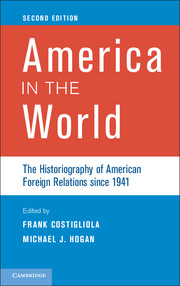Book contents
- Frontmatter
- Dedication
- Contents
- List of Contributors
- Preface
- 1 Introduction
- 2 The Charlie Maier Scare and the Historiography of American Foreign Relations, 1959–1980
- 3 Chaps Having Flaps: The Historiography of U.S. Foreign Relations, 1980–1995
- 4 Still Contested and Colonized Ground: Post–Cold War Interpretations of U.S. Foreign Relations during World War II
- 5 Recent Literature on Truman’s Atomic Bomb Decision
- 6 The Cold War
- 7 Cold War Presidents: Dwight D. Eisenhower, John F. Kennedy, Lyndon Baines Johnson, and Richard M. Nixon
- 8 The War that Never Ends: Historians and the Vietnam War
- 9 Culture and the Cold War: U.S.–Latin American Historiography since 1995
- 10 Impatient Crusaders: The Making of America’s Informal Empire in the Middle East
- 11 Explaining the Rise to Global Power
- 12 Bringing the Non-State Back In
- 13 Technology and the Environment in the Global Economy
- 14 U.S. Mass Consumerism in Transnational Perspective
- 15 A Worldly Tale
- Index
- References
1 - Introduction
Published online by Cambridge University Press: 05 June 2014
- Frontmatter
- Dedication
- Contents
- List of Contributors
- Preface
- 1 Introduction
- 2 The Charlie Maier Scare and the Historiography of American Foreign Relations, 1959–1980
- 3 Chaps Having Flaps: The Historiography of U.S. Foreign Relations, 1980–1995
- 4 Still Contested and Colonized Ground: Post–Cold War Interpretations of U.S. Foreign Relations during World War II
- 5 Recent Literature on Truman’s Atomic Bomb Decision
- 6 The Cold War
- 7 Cold War Presidents: Dwight D. Eisenhower, John F. Kennedy, Lyndon Baines Johnson, and Richard M. Nixon
- 8 The War that Never Ends: Historians and the Vietnam War
- 9 Culture and the Cold War: U.S.–Latin American Historiography since 1995
- 10 Impatient Crusaders: The Making of America’s Informal Empire in the Middle East
- 11 Explaining the Rise to Global Power
- 12 Bringing the Non-State Back In
- 13 Technology and the Environment in the Global Economy
- 14 U.S. Mass Consumerism in Transnational Perspective
- 15 A Worldly Tale
- Index
- References
Summary
Although Michael J. Hogan had commissioned the essays in the first edition of America in the World: The Historiography of American Foreign Relations since 1941 (1995), he was not entirely satisfied with the outcome. The primary problem lay not with the authors, whose essays were excellent, but with the state of the literature they were reviewing. That scholarship was “not always sophisticated” in terms of its conceptual design or methodology. Hogan wanted to see “exciting new work on the cultural aspects of diplomacy and warfare.” He also believed that “diplomatic historians need[ed] to evaluate the role of gender in foreign policy, as well as race.” They should “write more comparative history as well as more international history,” he suggested, and could broaden the study of non-state actors “to include ethnic, racial, religious, and women’s groups, as well as business and labor organizations.” In addition, history should encompass matters relating to the economy, the environment, and human rights and, at the same time, address the “equally pressing ... need for more broad overviews.” An ambitious agenda!
Now, nearly twenty years later, it is time to revisit the original agenda, in collaboration with a coeditor, to see how far the field has come and what still needs to be done. This is the purpose of this second edition, which revises the original essays in light of recent literature and adds new essays as well. We are happy to report that according to two high-profile appraisals, much of the original agenda, however ambitious, has been realized. Thomas W. Zeiler (2009) and Erez Manela (2011) both concur that historians are pursuing, and indeed going beyond, the new topics and approaches urged in the first edition of this volume.
- Type
- Chapter
- Information
- America in the WorldThe Historiography of American Foreign Relations since 1941, pp. 1 - 8Publisher: Cambridge University PressPrint publication year: 2013



